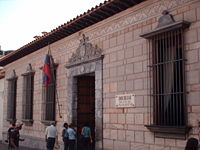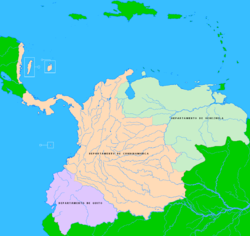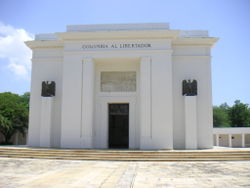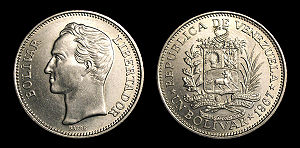Simón Bolívar
2008/9 Schools Wikipedia Selection. Related subjects: Historical figures
|
Simón Bolívar
|
|
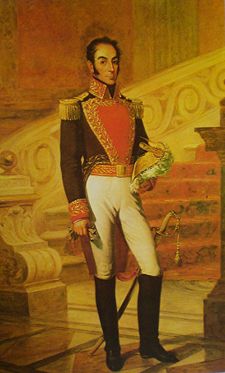 |
|
|
2nd President of Venezuela
|
|
|---|---|
| In office August 6, 1813 – July 7, 1814 |
|
| Preceded by | Cristóbal Mendoza |
|
3rd President of Venezuela
|
|
| In office February 15, 1819 – December 17, 1819 |
|
| Succeeded by | José Antonio Páez |
|
1st President of Colombia
|
|
| In office December 17, 1819 – May 4, 1830 |
|
| Succeeded by | Domingo Caycedo |
|
1st President of Bolivia
|
|
| In office August 12, 1825 – December 29, 1825 |
|
| Succeeded by | Antonio José de Sucre |
|
6th President of Peru
|
|
| In office February 17, 1824 – January 28, 1827 |
|
| Preceded by | José Bernardo de Tagle, Marquis of Torre-Tagle |
| Succeeded by | Andrés de Santa Cruz |
|
|
|
| Born | July 24, 1783 Caracas, Venezuela |
| Died | December 17, 1830 (aged 47) Santa Marta, Colombia |
| Spouse | María Teresa Rodríguez del Toro y Alaysa |
| Signature |  |
Simón José Antonio de la Santísima Trinidad Bolívar y Palacios Blanco, or more commonly known as Simón Bolívar ( July 24, 1783 – December 17, 1830), was one of the most important leaders of Spanish America's successful struggle for independence from Spain, along with Argentinian general José de San Martín.
After the triumph over the Spanish monarchy, Bolívar participated in the foundation of Gran Colombia, a nation formed from the liberated Spanish colonies. Bolívar became President of Gran Colombia from 1821 to 1830, President of Peru from 1824 to 1826 and President of Bolivia from 1825 to 1826. His legacy contributed decisively to the independence of present-day Bolivia, Colombia, Ecuador, Panamá, Perú and Venezuela.
Family heritage and early life
Simón Bolívar was born in Caracas, Captaincy General of Venezuela (now Venezuela). The Bolívar aristocratic bloodline derives from a small village in the Basque Country, called Bolibar, which is the origin of the surname. His father descended remotely from King Fernando III of Castile and Count Amedeo IV of Savoy, and was provenient in male line of the family de Ardanza. The Bolívars settled in Venezuela in the sixteenth century.
A portion of their wealth came from the Aroa River gold and copper mines in Venezuela. In 1632, gold was first mined, leading to further discoveries of extensive copper deposits. Towards the later 1600s, copper was exploited with the name "Cobre Caracas". These mines became the property of Simón Bolívar's family. Later in his revolutionary life, Bolívar used part of the mineral income to finance the South American revolutionary wars. Some people claim that his family grew to prominence before gaining great wealth. For example, the Caracas Cathedral, founded in 1575, has a side chapel dedicated to Simón Bolívar's family.
Following the death of his father Juan Vicente Bolívar y Ponte, 1st Marqués de San Luis, and his mother María de la Concepción Palacios y Blanco, he went to Spain in 1799 to complete his education. There he married María Teresa Rodríguez del Toro y Alaysa in 1802, but on a brief return visit to Venezuela in 1803, she succumbed to yellow fever. Bolívar returned to Europe in 1804 and for a time was part of Napoleon's retinue.
El Libertador
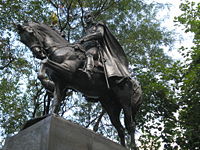
Bolívar returned to Venezuela in 1807, and, when Napoleon made Joseph Bonaparte King of Spain and its colonies in 1808, he participated in the resistance juntas in South America. The Caracas junta declared its independence in 1810, and Bolívar was sent to Britain on a diplomatic mission.
Bolívar returned to Venezuela in 1811. In March 1812, Bolívar was forced to leave Venezuela because of an earthquake that destroyed Caracas. In July 1812, junta leader Francisco de Miranda surrendered to the Spanish, and Bolívar had to flee to Cartagena de Indias. It was during this period that Bolívar wrote his Manifesto de Cartagena. In 1813, after acquiring a military command in New Granada under the direction of the Congress of New Granada in Tunja, he led the invasion of Venezuela on May 14. This was the beginning of the famous Admirable Campaign. He entered Mérida on May 23, where he was proclaimed as El Libertador, following the occupation of Trujillo on June 9. Six days later, on June 15, he dictated his famous Decree of War to the Death ( Decreto de Guerra a Muerte). Caracas was retaken on August 6, 1813, and Bolívar was ratified as "El Libertador", thus proclaiming the Venezuelan Second Republic. Due to the rebellion of José Tomás Boves in 1814 and the fall of the republic, he returned to New Granada, where he then commanded a Colombian nationalist force and entered Bogotá in 1814, recapturing the city from the dissenting republican forces of Cundinamarca. He intended to march into Cartagena and enlist the aid of local forces in order to capture Royalist Santa Marta. However, after a number of political and military disputes with the government of Cartagena, Bolívar fled, in 1815, to Haiti, where he befriended the leader of the newly independent country. Bolívar (granted sanctuary in Haiti) petitioned the Haitian leader Alexandre Pétion for aid.
In 1817, with Haitian soldiers and vital material support (on the condition that he abolish slavery), Bolívar landed in Venezuela and captured Angostura (now Ciudad Bolívar).
A victory at the Battle of Boyacá in 1819 added New Granada to the territories free from Spanish control, and in September 7, 1821 the Gran Colombia (a federation covering much of modern Venezuela, Colombia, Panama, and Ecuador) was created, with Bolívar as president and Francisco de Paula Santander as vice president.
Further victories at the Carabobo in 1821 and Pichincha in 1822 consolidated his rule over Venezuela and Ecuador respectively. After a meeting in Guayaquil, on July 26 and July 27, 1822, with Argentine General José de San Martín, who had received the title of Protector of Peruvian Freedom, in August 1821, after having partially liberated Peru from the Spanish, Bolívar took over the task of fully liberating Peru. The Peruvian congress named him dictator of Peru, on February 10, 1824, which allowed Bolívar to completely reorganize the political and military administration. Bolívar, assisted by Antonio José de Sucre, decisively defeated the Spanish cavalry, on August 6, 1824, at Junín. Sucre destroyed the still numerically superior remnants of the Spanish forces at Ayacucho on December 9.
On August 6, 1825, at the Congress of Upper Peru, the Republic of Bolivia was created. Bolívar is thus one of the few men to have a country named after him. The constitution reflected the influence of the French and Scottish Enlightenment on Bolívar's political thought, as well as that of classical Greek and Roman authors.
Bolívar had great difficulties maintaining control of the vast Gran Colombia. During 1826, internal divisions had sparked dissent throughout the nation and regional uprisings erupted in Venezuela, thus the fragile South American coalition appeared to be on the verge of collapse.
An amnesty was declared and an arrangement was reached with the Venezuelan rebels, but political dissent in New Granada grew as a consequence of this. In an attempt to keep the federation together as a single entity, Bolívar called for a constitutional convention at Ocaña during April 1828.
He had seen his dream of eventually creating an American Revolution-style federation between all the newly independent republics, with a government ideally set-up solely to recognize and uphold individual rights, succumb to the pressures of particular interests throughout the region, which rejected that model and allegedly had little or no allegiance to liberal principles.
For this reason, and to prevent a break-up, Bolívar wanted to implement in Gran Colombia a more centralist model of government, including some or all of the elements of the Bolivian constitution he had written (which included a lifetime presidency with the ability to select a successor, though this was theoretically held in check by an intricate system of balances).
This move was considered controversial and was one of the reasons why the deliberations met with strong opposition. The convention almost ended up drafting a document which would have implemented a radically federalist form of government, which would have greatly reduced the powers of the central administration.
Unhappy with what would be the ensuing result, Bolívar's delegates left the convention. After the failure of the convention due to grave political differences, Bolívar proclaimed himself dictator on August 27, 1828 through the "Organic Decree of Dictatorship".
He considered this as a temporary measure, as a means to reestablish his authority and save the republic, though it increased dissatisfaction and anger among his political opponents. An assassination attempt on September 25, 1828 failed, in part thanks to the help of his lover, Manuela Sáenz, according to popular belief.
Although Bolívar emerged physically intact from the event, this nevertheless greatly affected him. Dissident feelings continued, and uprisings occurred in New Granada, Venezuela and Ecuador during the next two years.
Death and Legacy
Bolívar finally resigned his presidency on April 27, 1830, intending to leave the country for exile in Europe, possibly in France. He had already sent several crates (containing his belongings and his writings) ahead of him to Europe.
He died before setting sail, after a painful battle with tuberculosis on December 17, 1830, in the Quinta de San Pedro Alejandrino in Santa Marta, Gran Colombia (now Colombia).
His remains were moved from Santa Marta to Caracas in 1842, where a monument was set up for his burial in the Panteón Nacional. The 'Quinta' near Santa Marta has been preserved as a museum with numerous references to his life.
Relatives
Simón Bolívar has no direct descendants. His bloodline lives on through his sister Juana Bolívar y Palacios who married their maternal uncle Dionisio Palacios y Blanco and had two children: Guillermo and Benigna.
Guillermo died when fighting alongside his uncle in the battle of La Hogaza in 1817. Benigna Palacios y Bolívar married Pedro Amestoy. Their great-grandchildren, Pedro (95), and Eduardo Mendoza Goiticoa (90) live in Caracas. They are Simón Bolívar's closest living relatives.
Political legacy
Simón Bolívar's political legacy has of course been massive and he is a very important figure in South American political history. Claims to the mantle of Simón Bolívar of have continued throughout modern times via the various shades of ' Bolivarianism' including Hugo Chávez's recent movement.
On his deathbed, Bolívar asked his aide-de-camp, General Daniel Florencio O'Leary to burn the extensive archive of his writings, letters, and speeches. O'Leary disobeyed the order and his writings survived, providing historians with a vast wealth of information about Bolívar's liberal philosophy and thought.
He was a great admirer of the American Revolution and a great critic of the French Revolution. Bolívar described himself in his many letters as a " liberal". Among the books he traveled with when he wrote the Bolivian Constitution one is Montesquieu's Spirit of the Laws.
Honours
In addition to the statues shown elsewhere in this article, there is an equestrian statue commemorating Bolívar's life and works in Washington, D.C., a statue at the UN Plaza in San Francisco, a statue in Rivadavia Park, Buenos Aires, Argentina, a statue in the Basque Country, Spain, a statue on the Reforma Avenue in Mexico City, a statue in Kingston, Jamaica, a statue in Cairo, Egypt. There is a five meter tall equestrian statue in San Salvador, El Salvador, in a square also called "Plaza Bolívar". A statue in San Juan de Puerto Rico, a statue signifying the friendship between Canada and South America in Ottawa (which caused some controversy at the time of its erection), and also a bust in Sydney, Australia and an equestrian statue in Quebec City, in the Parc de l'Amérique Latine. A statue in Bolivar, Missouri which was presented by President Rómulo Gallegos of Venezuela and dedicated by President Harry S. Truman. A central avenue in Ankara, the capital of Turkey, bears his name. Bolivar, West Virginia bears his name and displays his bust, and Frankfurt, Germany also has a bust of the general
Furthermore, every city and town in Venezuela & Colombia (in this one each capital city but Pasto) have a main square known as Plaza Bolívar, that usually has a bust or a statue of Bolívar, the most famous of these Plaza Bolívar are the ones in Bogotá and Caracas. The central avenue of Caracas is called Avenida Bolívar, and at its end there is a twin tower complex named Centro Simón Bolívar built during the 1950s that holds several governmental offices.
Places named in honour of Bolívar
- In Argentina:
- Bolivar, Buenos Aires Province
- Bolivia
- In Colombia:
- Bolívar Department
- Bolívar, Cauca
- Bolívar, Santander
- Bolívar, Valle del Cauca
- El Carmen de Bolívar, Bolívar
- Bolívar Square, Bogotá
- Pico Simón Bolívar
- Ciudad Bolívar, locality in Bogotá
- Simón Bolívar Park, Bogotá
- In Ecuador:
- Bolívar Province, Ecuador
- In El Salvador:
- Bolívar (town), in La Union province
- In Peru:
- Bolívar District
- Bolívar, the capital of Bolívar District
- Bolívar Province, in La Libertad Region
- In the United States:
- Bolivar, Tennessee
- Mount Bolivar, a mountain in Coos County, Oregon
- Bolivar, Ohio
- Bolivar, Missouri
- Bolivar, West Virginia
- Bolivar County, Mississippi
- Bolivar (town), New York
- Bolivar (village), New York
- The Bolivar Peninsula in Galveston County, southern Texas
- In Venezuela:
- Bolívar State
- Ciudad Bolívar, capital of Bolívar State
- Pico Bolívar, Highest Peak in Venezuela
- Various streets in New Orleans, New Delhi, India, Mexico City, Mexico, Ankara, Turkey, Cairo and Guatemala City are named after Simón Bolívar
- A suburb of Adelaide, South Australia is named Bolivar after him
Other
- The Simón Bolívar United World College of Agriculture in Venezuela, a school in Venezuela that offers a diploma in agriculture, and that is part of the United World College Movement.
- Venezuelan bolívar, the currency of Venezuela
- The Puerto Bolívar Airport, a private airport in the Guajira Department of Colombia
- The Bolívar cigar brand from Cuba
- El Club Bolívar, a Bolivian football team who play at the Estadio Libertador Simón Bolívar
- The Simón Bolívar Symphony Orchestra (Orquesta Sinfónica Simón Bolívar)'
- USS Simon Bolivar (SSBN-641)
